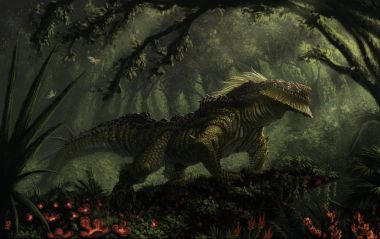Difference between revisions of "Basilisk"
m |
Tao alexis (talk | contribs) |
||
| Line 1: | Line 1: | ||
| − | [[File:Basilisk image.jpg| | + | [[File:Basilisk-image.jpg|380px|left|Basilisk]] |
{{Bestiarychart | {{Bestiarychart | ||
| name = Basilisk | | name = Basilisk | ||
Revision as of 19:39, 18 February 2020
| Species | beast |
| No. Appearing | 1–2 |
| Behaviour | presocial |
| Range | steppe, subterannean |
| Size | 7 ft. long |
| Weight | 110 lbs. |
| Intelligence | 1 |
| Armour Class | 4 |
| Hit Dice | 6+1 |
| Action Points | 3 |
| Max. Stride | {{{stride}}} |
| THAC0 | 15 |
| Hp/Die | d6 |
| Attack Forms | bite |
| Damage | 1–10 |
| Special Attacks | petrification, surprise 4 in 6 |
Reptilian-like in appearance, the basilisk possesses a powerful attack in the form of a gaze that transforms enemies into stone. Any creature forced to roll initiative with the basilisk or attempting to attack it must either roll save against petrification or fight the beast with eyes closed (treating it as invisible and withdrawn, -8 to hit). The basilisk makes very little sound and may, if it wishes, conceal itself among stone or beneath undergrowth so as to be undetectable at a distance of more than one combat hex.
The beast's preferred method of attack a single prey for meat, which it will not turn to stone by means of a second eyelid. If attacked by multiple opponents, however, it will turn all except its intended prey to stone without hesitation, the eyelid opening and snapping shut in an instant as needed. Its intended prey is safe from petrification and need not make save, but all attacks from the basilisk's jaws (causing 1–10 damage) will be directed at this prey.
Contrary to popular myth, the glance of a basilisk cannot be turned by a mirror so that the basilisk will turn itself to stone. However, the basilisk may be observed safely through a mirror. Though attacking the basilisk hand-to-hand with a mirror for aid is impractical, characters may use a mirror to fire a weapon at a basilisk, with a -5 penalty to hit. Note that the basilisk will never be far from cover or stone, however, and once struck will quickly move into a camouflaged position.
Basilisks will often consume stones to ease its digestive process. When consuming humanoid prey, the basilisk will also swallow gems, which will remain in its belly for months.
Encounters
- Camouflaged: the basilisk will wait in camouflage for its prey to move within attacking range. It will prefer a single prey, which it will attack by moving forward one hex and attacking, if that single prey moves to within 10 feet of the camouflaged beast (2 hexes). At two hexes, the beast cannot be observed, but its presence will be revealed by detect malevolence or enemies. If passing prey is part of a humanoid or carnivorous group, the basilisk will instinctively remain hidden — but if someone does move within a hex of the beast, its presence will become immediately evident (no roll required).
- Wandering: the basilisk has chosen to change its location and will be discovered moving openly along a hall, through a cavern or across an area of open scrub. Typically, it will be observed at a distance of 9–16 hexes. There is only a 15% chance that the basilisk will be moving in a direction that will require the first observer (roll randomly) to make a saving throw against petrification. If sighted and avoided, then the basilisk will continue on its way without attacking.
See Bestiary.
